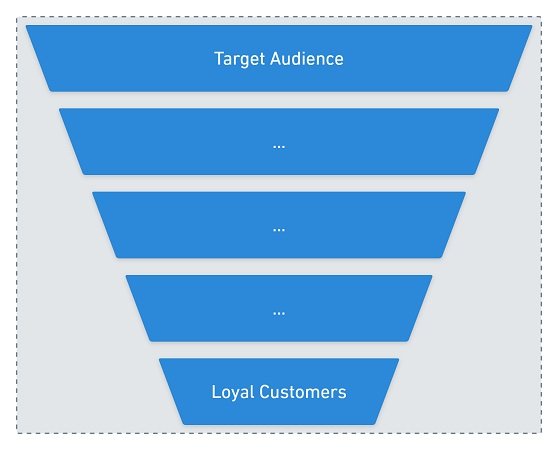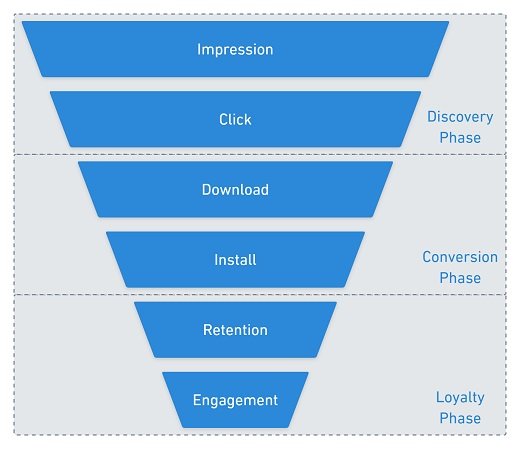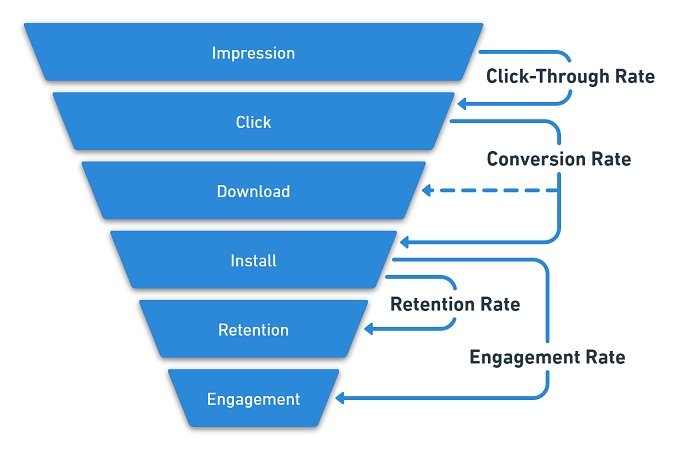If you read about Mobile Marketing regularly, you are most likely aware of its different disciplines, such as App Store Optimization, User Acquisition, Retention and Engagement Marketing, or Monetization. But have you also learned how to connect these disciplines to create a seamless marketing strategy?
In case you have not, this article is for you. It will introduce you to a crucial (maybe the most crucial concept) in app marketing: the Mobile Marketing Funnel.
WHAT IS THE MOBILE MARKETING FUNNEL?
The Mobile Marketing Funnel is a concept in app marketing that breaks down the user journey from noticing an app to becoming a loyal and valuable user into three phases with six stages. It connects the single disciplines of Mobile Marketing and explains their impact on the success of an app business.
THE ROLE OF FUNNELS IN MARKETING
Funnels are very popular tools in all fields of marketing. They explain understandably the process of discovering, evaluating, and using a product or service that every (potential) user goes through. All marketing funnels, including the Mobile Marketing Funnel, follow the same presumptions:
- Each funnel contains different stages or steps that are connected to a specific action that the user has to perform.
- Only users who perform the required action on a specific stage will proceed to the next stage.
- On each stage, some users will not perform the action that is necessary to proceed. Instead, they will churn out of the process. As a result, the number of people will decrease from stage to stage.
- Only users who make it all the way down the funnel to the last stage will become valuable customers for the product or service provider.
This process is visualized with trapezoid blocks that symbolize the single stages and are stacked on each other. The block on top stands for the users that enter the process, the block at the bottom represents those who become loyal customers. The blocks in between show people in different phases of the decision-making process. The more users churn out on a stage, the smaller get the blocks. As a result, the stacked blocks look like a funnel.

Generic Example of a Marketing Funnel
THE SIX STAGES OF THE APP USER JOURNEY
The Mobile Marketing Funnel, as it was introduced by TUNE, differs three phases with two stages each that users have to complete in order to become loyal customers of your app business.
- the Discovery Phase with the Impression Stage and the Click Stage
- the Conversion Phase with the Download Stage and the Install Stage
- the Loyalty Phase with the Retention Stage and the Engagement Stage

The Mobile Marketing Funnel
The Discovery Phase
Before people can use your app, they have to become aware of it. They need to learn about its features and its capabilities to solve their problems.
Step 1: The Impression Stage
The first stage of the Mobile Marketing journey is the user’s exposure to an impression. He must see, hear, or read about it. The term impression includes many different means of making users aware of an app:
- a classical ad impression that you booked via an ad network, such as a banner, an interstitial, a text ad, a native ad, or a video
- the appearance of your app on a SERP, the top charts, or in a feature in the app stores
- a post on social media, done by you as the app owner or by another user of your app
- a review about your app or similar editorial content on a blog or news website
The exposure to an impression is not a step that the user performs voluntarily. Instead, it is the result of your marketing activities as the app owner. Nevertheless, for the purpose of simplicity, we will consider it a step equivalent to the voluntary steps that will follow in the journey.
Step 2: The Click Stage
Clicking the ad, the search result or the social media post will forward people to your app’s product page on the app store. This is the first voluntary action they perform in their app marketing journey, and it indicates that they have a basic level of interest in your app and want to learn more about it.
Be aware that there are several synonyms to the term click that are used in Mobile Marketing, for instance:
- tab (used f.e. on the Apple Search Ads platform)
- page view (used in the Analytics section of App Store Connect)
Although the names differ, they all mean the same action: clicking an ad and visiting the app’s product page.
The Conversion Phase
When people arrive on the product page, they will get a lot more information about the app, such as the app description, screenshots, videos, and ratings and reviews. Depending on this metadata, they will evaluate whether the app has the ability to solve their problems or not. If they think it has, they will convert from potential into actual users.
Step 3: The Download Stage
When users click the download button on the product page, they signal that their decision-making process ended with a result in favor of the app. They are convinced about its ability to help them and want to test it. And in case, the evaluated app is a premium app, this also means that they are willing to pay for it.
Step 4: The Install Stage
After the download of the APK or IPA file, the user’s device automatically installs the app. For this reason, it seems logical to consider the download and the install one combined step.
But technically, they are not: A download is counted when the user clicks the download button on the product page, no matter whether the download and installation process completes successfully or is disrupted. On the other hand, an install is only counted when the user opens the app for the first time after downloading and installing it. So it requires an additional, voluntary action for the install: clicking the app icon on the device’s home screen to launch it.
For this reason, it is reasonable to think of the install as a separate stage.
The Loyalty Phase
The first usage of your app gives users first-hand information about its content and features. They will use this information to determine whether they want to continue to use your app.
Step 5: The Retention Stage
Retention is the first step toward a deeper relationship between you (respectively your app) and users. They have to decide to return to your app and use it again frequently to become loyal users.
Step 6: The Engagement Stage
Finally, users who return to your app, need to start engaging with it on a deeper level. Depending on your app, many different actions can qualify for engagement, including:
- using your app longer and more frequently
- writing a positive app store review
- interacting with other users
- spending money on in-app purchases or physical products from the app
HOW MOBILE MARKETING DISCIPLINES IMPACT THE FUNNEL
The various disciplines of Mobile Marketing impact different stages of the Mobile Marketing Funnel. If you find out that your users tend to churn out of the funnel at specific stages, you can use these connections to identify the right means to fix that problem.
App Store Optimization
The sub-disciplines of App Store Optimization impact three different stages of the Mobile Marketing Funnel:
Keyword optimization impacts the impression stage. By pushing apps into SERPs, you can increase its visibility, so more users come across it when searching for new apps.
Learn more: HOW TO DO APP STORE KEYWORD RESEARCH FOR IOS AND ANDROID
Conversion Rate Optimization affects the click and the download stage. By optimizing the metadata that is visible on SERPs, in top charts, and in features, you will increase the number of users who click it and visit your product page. And by improving the rest of your metadata, you will convince more people to hit the download button.
User Acquisition
Paid user acquisition affects two stages of the funnel:
Media buying has a positive impact on the impression and the click stage. By paying for ad space, you make users aware of your app who might have not found it otherwise. To some degree, you can also increase the number of clicks. To do so, you need to optimize the channels you use for user acquisition granularly and increase the chance of reaching people who are interested in your app.
Learn more: 5 POWERFUL APP MARKETING STRATEGIES FOR SMALL BUDGETS
Creative optimization affects the click stage. Just like you can optimize app store metadata, you can make your ad banners, videos, and text ads more interesting or more beautiful to encourage more users to click them.
Retention & Engagement Marketing
Retention and Engagement Marketing affects the retention stage as well as the engagement state. By providing a proper onboarding process and other helpful tools, you will increase the percentage of users who keep using your app. And with push notification marketing and similar tactics, you can bring people who abandoned your app back into it and encourage them to use it more often and more intensively.
Learn more: 12 METHODS TO INCREASE MOBILE APP USER RETENTION
Monetization
Monetization measures have an impact on the engagement stage. The proper means will encourage your users to spend more money on your app. This includes balancing the in-app economy, finding the right pricing for IAPs, optimizing in-app advertising, and other actions.
Learn more: 6 MONETIZATION STRATEGIES TO MAKE MONEY WITH YOUR APP

How Mobile Marketing Disciplines impact the Mobile Marketing Funnel
COST MODELS AND THE MOBILE MARKETING FUNNEL
You are probably aware that different pricing or cost models are used in app user acquisition. Each of these price models targets one stage of the Mobile Marketing Funnel. So by choosing the right price model for your user acquisition campaigns, you can determine which stage of the funnel you want to address:
- When buying traffic based on CPM, you target the impression stage. The same is true for the CPCV model that is often used for rewarded video campaigns.
- If you purchase clicks on a CPC basis, you aim at the click stage.
- The CPI model is used when the goal of a campaign is to create more installs, so it addresses the install stage.
- The purpose of CPE campaigns is to generate more post-install events. Depending on the exact conditions, they address either the retention or the engagement stage.
- CPS campaigns aim to increase purchases, so they target the engagement stage.

How Pricing Models are connected to the Mobile Marketing Funnel
CONVERSION METRICS AND THE MOBILE MARKETING FUNNEL
Conversion KPIs are very important in Mobile Marketing. They tell you how successful you manage to move your users from one stage of the funnel to the next. By doing so, they also point you to weaknesses in your marketing strategy and give you the chance to improve it. These are the most crucial KPIs and the funnel stages they address:
- The click-through rate shows you how many users move from the impression to the click stage. Or in other words, it tells you the percentage of users who click an ad that they see.
- The conversion rate lets you know which percentage of product page visitors download and install the app. Conversion rates can refer to the download stage or the install stage.
- The retention rate tells you how many users return to your app after completing the installation and opening it for the first time. So it connects the install stage and the retention stage.
- Engagement rates usually refer to one specific post-install event, and let you know how many users who installed the app also performed this specific event. They are somewhat special because they skip the retention stage and instead connect two stages that are not consecutive: the install stage and the engagement stage.
Learn more: 20 APP MARKETING KPIS THAT YOU SHOULD MONITOR AND OPTIMIZE

How Conversion Metrics are connected to the Mobile Marketing Funnel
AD FRAUD AND THE MOBILE MARKETING FUNNEL
Finally, the Mobile Marketing Funnel is a great concept to explain how fraudsters attack the mobile advertising ecosystem. Different types of fraud target different stages of the funnel. Understanding these connections can help you identify and prevent fraud:
- Ad stacking and background ads are tactics to attack the impression stage.
- Click spam and click bots target the click stage.
- Click injections, SDK spoofing, and install bots aim to inject fraudulent traffic at the install stage.
- With smart bots, fraudsters are able to attack the engagement stage.
- Device farms and compliance fraud can affect all of the stages mentioned above.
You might have realized that the download stage was not mentioned in the list. That is because only Apple and Google know when users click the download button in their app stores, and they do not share this data. In other words, tracking the download is not possible, thus ad networks cannot run campaigns based on downloads, and fraudsters have no entry point.
Learn more: WHAT IS MOBILE AD FRAUD AND HOW CAN YOU PROTECT YOUR APP?

How Fraud Types are connected to the Mobile Marketing Funnel
CONCLUSION
As you could see in this post, the Mobile Marketing Funnel is a central concept of app marketing. It can help you understand many different aspects of promoting your app and optimizing your marketing strategy. Whenever you plan a marketing activity, you should turn to the funnel and make clear to yourself at which stage this activity aims. Doing so will help you identify the right KPIs to monitor your success. Besides, you can use the funnel to find the right disciplines to address specific problems.
